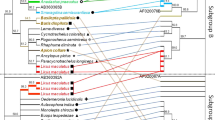Abstract
We studied the occurrence of Wolbachia in the parasitoid Gonatopus bonaerensis Virla (Hymenoptera: Dryinidae). In order to verify the existence of natural infections in the parasitoid, a field survey was conducted. Identification of Wolbachia was performed on the basis of 16S rDNA, wsp_F1, and wsp_R1-sequences. After the detection of the bacteria, infected specimens of G. bonaerensis were treated with a solution of tetracycline. In Tucumán, parasitoids hold Wolbachia endosymbiont, which seems to control the wasp’s reproduction in the nature turning it into thelytokous. The symbiont was identified as the Wolbachia sp. wRi strain. The cure of infected unfertilized females determined the normal arrhenotokous parthenogenesis and the production of male offspring. As a consequence of this procedure, the male of G. bonaerensis is described for the first time.

Similar content being viewed by others
References
Arakaki N, Noda H, Yamagishi K (2000) Wolbachia-induced parthenogenesis in the egg parasitoid Telenomus nawai. Entomol Exp Appl 96:177–184
Gan B, Zhou W, Feng L, Shen D, Li C (2002) Infection of Wolbachia in three planthopper species in China. Acta Entomol Sinica 45:14–17
Gauld I, Bolton B (1988) The Hymenoptera. Oxford Univ. Press, in association with Brithis Museum (Nat. History), p 332
Giorgini M (2001) Induction of males in thelitokous populations of Encarsia meritoria and Encarsia protransvena. A systematic tool. BioControl 46:427–438
Guglielmino A, Virla EG (1998) Postembryonic development of Gonatopus lunatus Klug (Hymenoptera: Dryinidae: Gonatopodinae) with notes on its biology. Ann Soc Entomol Fr 34:321–333
Guglielmino A, Olmi M, Bückle C (2013) An updated host-parasite catalogue of world Dryinidae (Hymenoptera: Chrysidoidea). Zootaxa 3740:1–113
Jamnongluk W, Kittayapong P, Baimai V, O’Neill SL (2002) Wolbachia infections of Tephritid fruit flies: molecular evidence for five distinct strains in a single host species. Curr Microbiol 45:255–260
Klasson L, Westberg J, Sapountzis P, Naslund K, Lutnaes Y, Darby AC, Veneti Z, Chen L, Braig HR, Garrett R, Bourtzis K, Andersson SG (2009) The mosaic genome structure of the Wolbachia wRi strain infecting Drosophila simulans. P Natl Acad Sci Usa 106:5725–5730
Mazur MA, Holecová M, Lachowska-Cierlik D, Lis A, Kubisz D, Kajtoch Ł (2016) Selective sweep of Wolbachia and parthenogenetic host genomes—the example of the weevil Eusomus ovulum. Insect Mol Biol. doi:10.1111/imb.12255
Noda H, Miyoshi T, Zhang Q, Watanabe K, Deng K, Hoshizaki S (2001) Wolbachia infection shared among planthoppers (Homoptera: Delphacidae) and their endoparasite (Strepsiptera: Elenchidae): a probable case of interspecies transmission. Mol Ecol 10:2101–2106
Normark BB (2003) The evolution of alternative genetic systems in insects. Annu Rev Entomol 48:397–423
O’Neill SL, Giordano R, Colbert AME, Karr TL, Robertson HM (1992) 16S rRNA phylogenetic analysis of the bacterial endosymbionts associated with cytoplasmic incompatibility in insects. P Natl Acad Sci Usa 89:2699–2702
O’Neill SL, Hoffmann AA, Werren JH (1997) Influential passengers, inherited microorganisms and arthropod reproduction. Oxford Univ. Press, New York, p. 232
Olmi M (1994) The Dryinidae and Embolemidae (Hymenoptera: Chrysidoidea) of Fennoscandia and Denmark. Fauna Entomologica Scandinavica Vol 30, Brill, p 98
Olmi M (1999) Hymenoptera Dryinidae – Embolemidae. Fauna d’Italia 37, Edizioni Calderini, Bologna: I-XVI, p 425
Olmi M (2000) Bio-ecologia degli Imenotteri Driinidi e loro impiego in programmi di lotta biologica. In: Lucchi A (ed) La Metcalfa negli ecosistemi italiani. ARSIA, Firenze, pp. 93–117
Olmi M, Virla EG (2014) Dryinidae of the Neotropical region (Hymenoptera: Chrysidoidea). Zootaxa 3792:1–534
Olmi M, Virla EG, Fernández FC (2000) Las Avispas Dryinidae de la Región Neotropical (Hymenoptera: Chrysidoidea). Biota Colomb 1:141–163
Plantard O, Solignac M (1998) Wolbachia-induced thelytoky in cynipids. U S For Serv Gen Tech Rep NC 199:111–121
Plantard O, Rasplus JY, Mondor G, Le Clainche I, Solignac M (1999) Distribution and phylogeny of Wolbachia inducing thelytoky in Rhoditini and ‘Aylacini’ (Hymenoptera: Cynipidae). Insect Mol Biol 8:185–191
Rasgon JL, Ren X, Petridis M (2006) Can Anopheles gambiae be infected with Wolbachia pipientis? Insights from an in vitro system. Appl Environ Microbiol 72:7718–7722
Rousset F, De Stordeur E (1994) Properties of Drosophila simulans experimentally infected by different clones of the bacterium Wolbachia. Heredity 72:325–331
Stouthamer R, Breeuwer JAJ, Luck RF, Werren JH (1993) Molecular identification of microorganisms associated with parthenogenesis. Nature 631:66–68
Virla EG (1997) New species of Gonatopodinae from the Neotropics (Hymenoptera Dryinidae). Boll Soc Entomol Ital 129:171–186
Virla EG (2004) Biología de Gonatopus bonaerensis (Hymenoptera: Drynidae), enemigo natural de Delphacidae (Hemiptera) en Argentina. Rev Fac Agr La Plata 105:18–26
Virla EG, Olmi M (2007) New records of Dryinidae from Argentina and descriptions of two new species (Hymenoptera: Chrysidoidea). Boll Zool Agr Bachicol 39:165–184
Virla EG, Olmi M (2008) Dryinidae. In: Debandi G, Claps LE, Roig-Juñent S (Eds.), Biodiversidad de Artrópodos Argentinos. Vol II SEA Ediciones Especiales, pp. 357–372
Waloff N (1974) Biology behaviour of some species of Dryinidae. J Entomol (A) 49:97–109
Werren JH, Windsor DM (2000) Wolbachia infection frequencies in insects: evidence of a global equilibrium? P Roy Soc Lond B Bio 267:1277–1285
Zhou W, Rousset F, O’Neill S (1998) Phylogeny and PCR-based classification of Wolbachia strains using wsp gene sequences. P Roy Soc Lond B Bio 265:509–515
Zouache K, Voronin D, Tran-Van V, Mousson L, Failloux A, Mavigui P (2009) Persistent Wolbachia and cultivable bacteria infection in the reproductive and somatic tissues of the mosquito vector Aedes albopictus. PLoS One 4:e6388. doi:10.1371/journal.pone.0006388
Acknowledgments
We thank to the anonymous reviewers for their very useful comments that improved the manuscript.
Author information
Authors and Affiliations
Corresponding author
Additional information
Edited by Gabriel Manrique - Univ Buenos Aires
Rights and permissions
About this article
Cite this article
Espinosa, M.S., Virla, E.G. & Cuozzo, S. Wolbachia Infections Responsible for Thelytoky in Dryinid Wasps. The Case of Gonatopus bonaerensis Virla (Hymenoptera: Dryinidae). Neotrop Entomol 46, 409–413 (2017). https://doi.org/10.1007/s13744-016-0475-x
Received:
Accepted:
Published:
Issue Date:
DOI: https://doi.org/10.1007/s13744-016-0475-x




